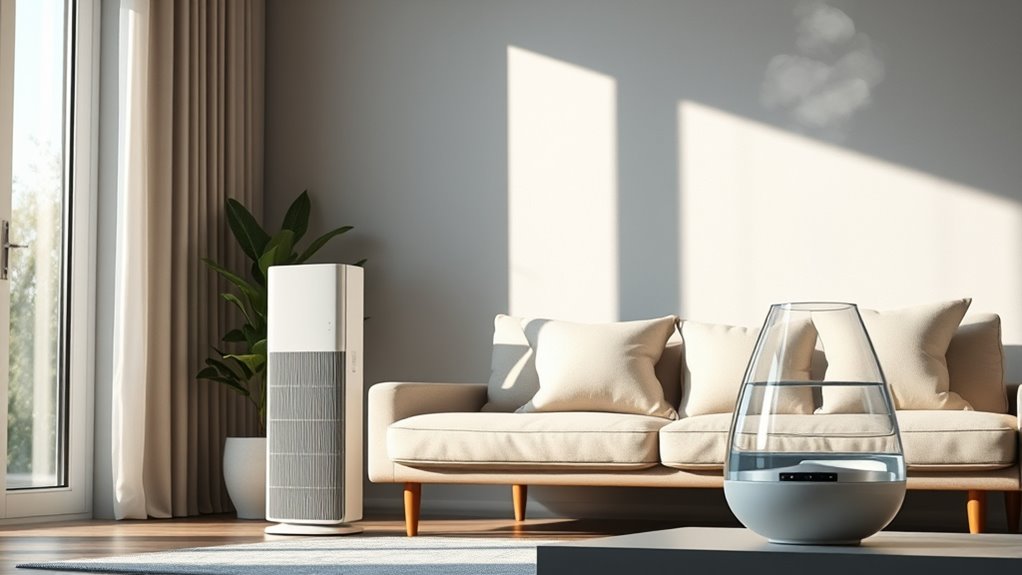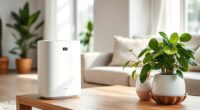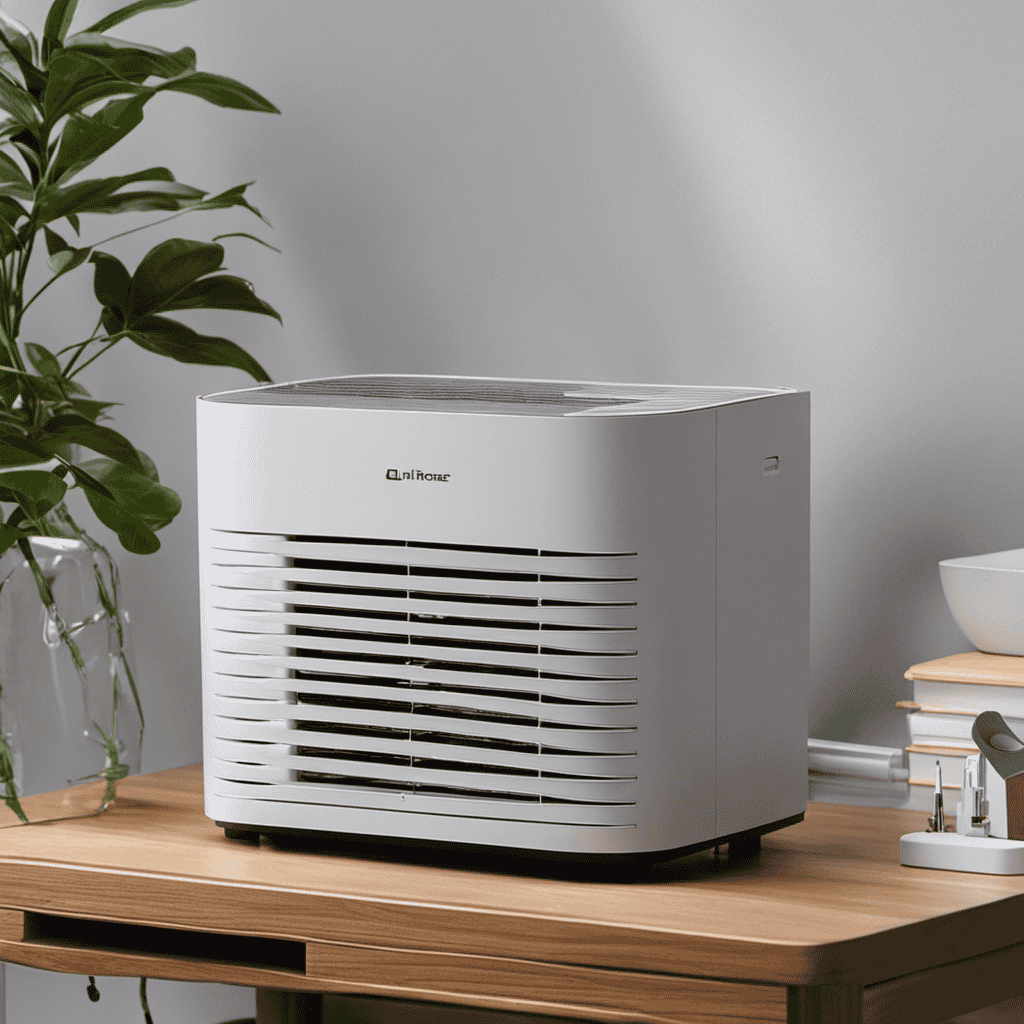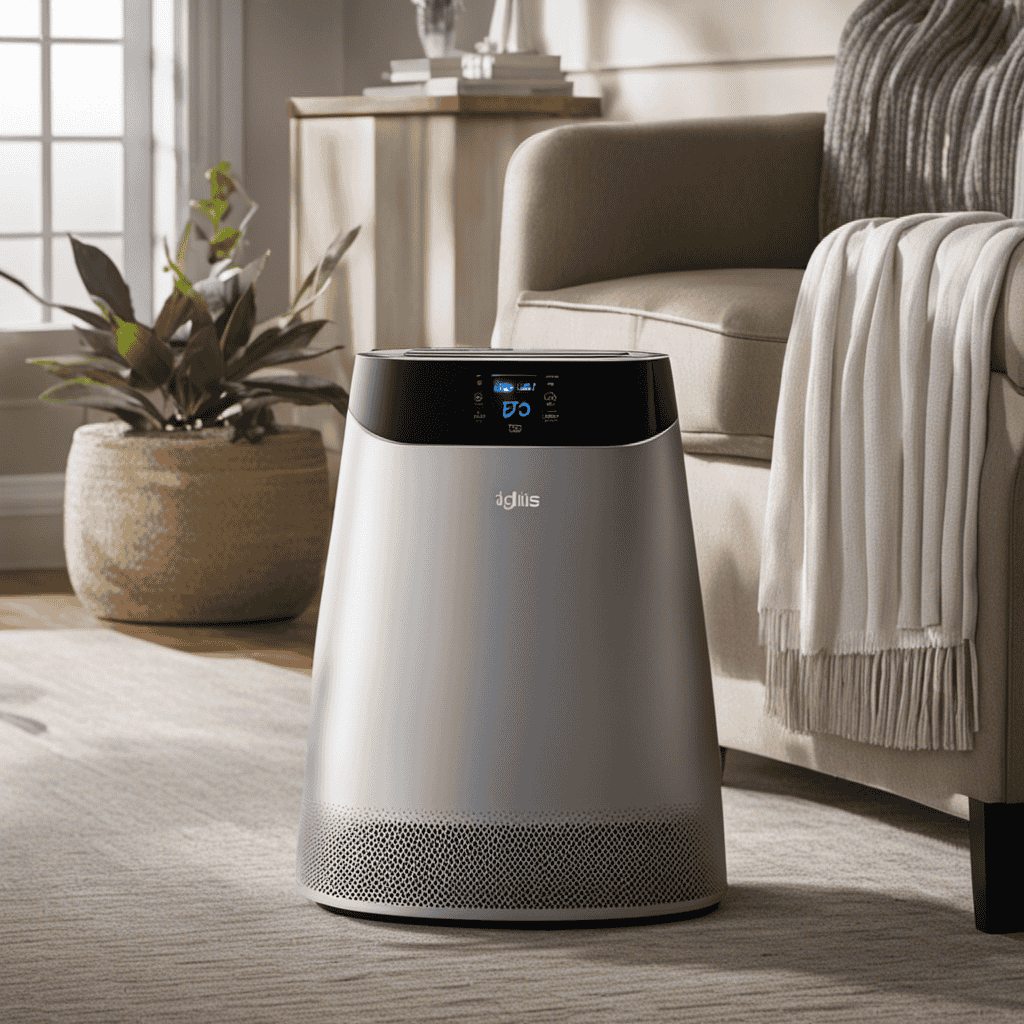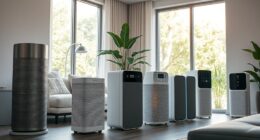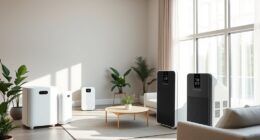If you’re struggling with airborne allergens, dust, or pollutants, an air purifier can help by trapping tiny particles and improving your indoor air quality. On the other hand, if dry air causes irritation, static, or skin issues, a humidifier adds moisture to ease discomfort and support better breathing. Sometimes, using both offers the best results. To find out which suits your space and needs best, discover more about their functions and benefits.
Key Takeaways
- Choose an air purifier if indoor air quality is compromised by dust, allergens, pollutants, or airborne pathogens.
- Opt for a humidifier if dry air causes skin irritation, respiratory discomfort, or static electricity.
- Combining both devices is ideal for maintaining clean, well-humidified indoor air, especially in polluted or dry environments.
- Consider room size, maintenance needs, and specific health concerns when selecting between air purifiers and humidifiers.
- Use an air purifier to reduce airborne contaminants and a humidifier to improve moisture levels for overall comfort and health.
How Do Air Purifiers Work?
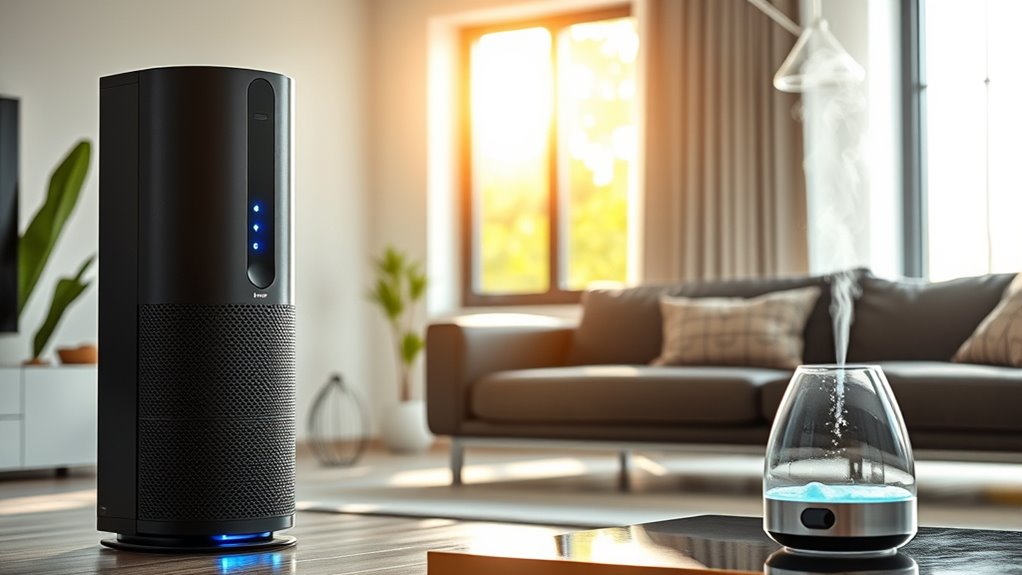
Air purifiers work by drawing in contaminated air and filtering out harmful particles before releasing cleaner air back into your space. To keep them running efficiently, regular air purifier maintenance is essential. This includes changing or cleaning filters as recommended by the manufacturer. Proper filter maintenance can significantly extend the lifespan of your device and ensure optimal performance. Neglecting maintenance can reduce their effectiveness and cause indoor air to stay polluted. While focusing on air purifier upkeep, don’t forget about humidifier cleaning, which helps prevent mold and bacteria growth that can worsen indoor air quality. Proper maintenance ensures your device effectively traps dust, allergens, and pollutants, improving your environment. When filters become clogged or dirty, the purifier’s performance drops, so stay diligent with maintenance routines. Clean filters and components regularly to enjoy fresher, healthier indoor air. Additionally, air quality monitoring devices can help you track indoor air conditions and identify when maintenance is needed. Regular filter replacement is also crucial to prevent buildup of contaminants that can compromise air quality. Incorporating effective cleaning practices can further enhance your device’s efficiency and indoor air health.
How Do Humidifiers Function?
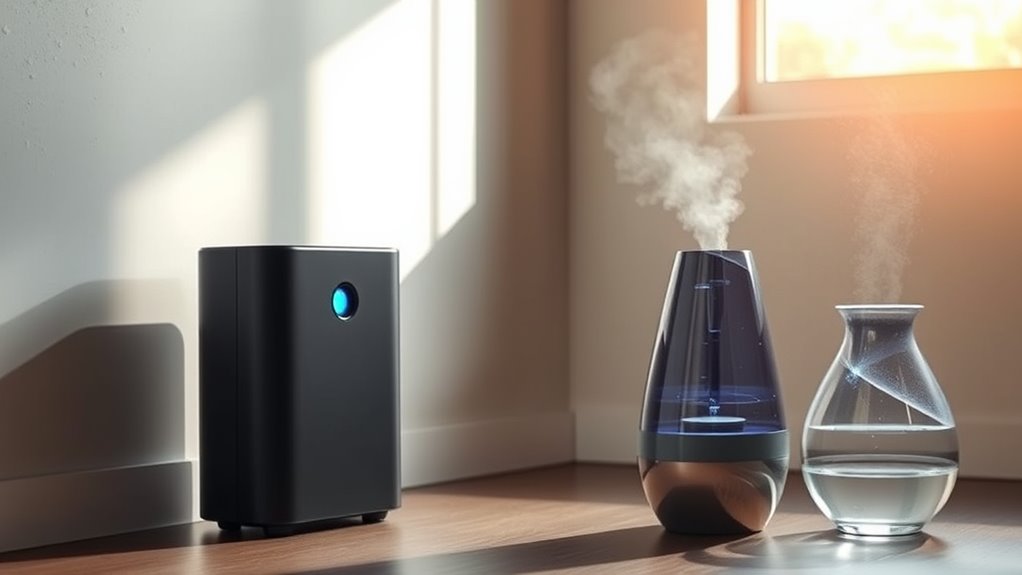
Humidifiers add moisture to the air by releasing water vapor, helping to maintain ideal humidity levels in your indoor environment. They typically operate through an evaporative process, where a wick or filter absorbs water from a reservoir. When the fan activates, air blows through the damp wick, causing water to evaporate into the surrounding air, increasing humidity. This natural process guarantees that moisture is added without over-saturating the room. The water vapor released helps prevent dryness, making breathing more comfortable and protecting your skin and respiratory passages. Some humidifiers use ultrasonic technology to produce a fine mist, while others rely on evaporation. Regardless of the method, the goal remains the same: to add controlled moisture and improve your indoor air quality. Utilizing the right humidification techniques can further optimize indoor comfort and health, especially when considering air quality improvements that can be achieved with proper humidifier operation. Additionally, selecting a humidifier with adjustable humidity settings can help maintain optimal moisture levels without excess.
Common Indoor Air Problems and Solutions
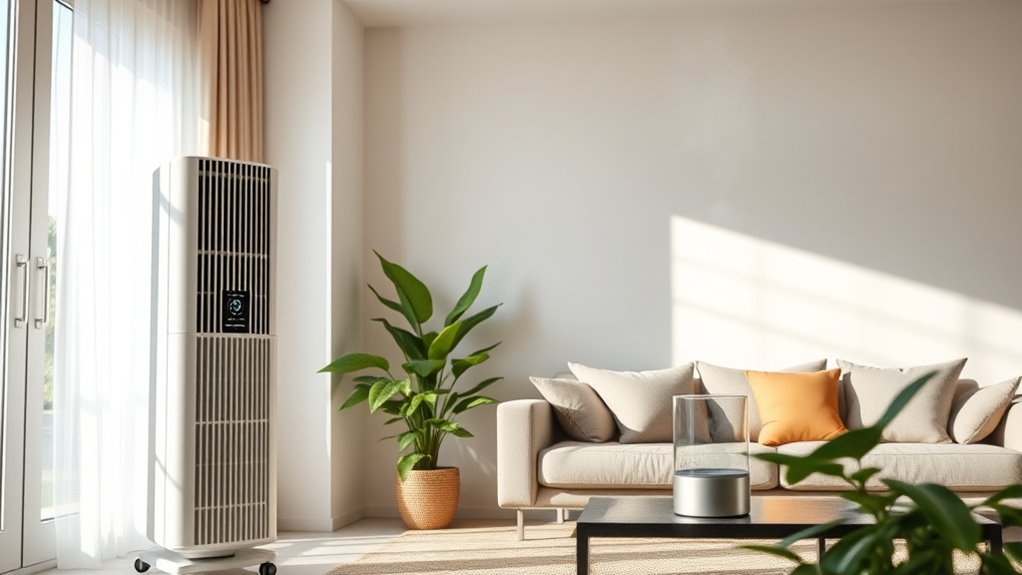
Indoor air quality often suffers from issues like dust, allergens, and pollutants that can cause health problems or discomfort. To identify these problems, air quality testing helps you pinpoint specific contaminants. Once you know what’s lurking in your air, you can take targeted steps to improve it. Regular device maintenance is essential for ensuring your air purifiers or humidifiers work effectively. Dirty filters or neglected equipment can worsen air quality instead of improving it. Keep filters clean, replace parts as recommended, and check your devices periodically. Addressing common indoor air problems isn’t just about choosing the right device; it’s about maintaining it properly and staying vigilant with air quality testing. This proactive approach keeps your home healthier and more comfortable. Additionally, understanding the noise levels of modern heat pumps can help ensure that your heating solutions do not contribute to indoor noise pollution, further supporting a healthy environment. Staying informed about AI-driven healthcare advances such as AI-discovered cures can also inspire innovative solutions for indoor air quality management. For example, emerging automation technologies are increasingly used to monitor and adjust indoor environments in real-time, enhancing air quality control efforts. Properly maintaining air quality devices is crucial because filter replacements and regular inspections prevent dust buildup and ensure optimal performance, ultimately improving indoor air health. Moreover, utilizing smart sensors can provide real-time feedback on air quality, enabling more precise control and timely maintenance.
Benefits of Using an Air Purifier
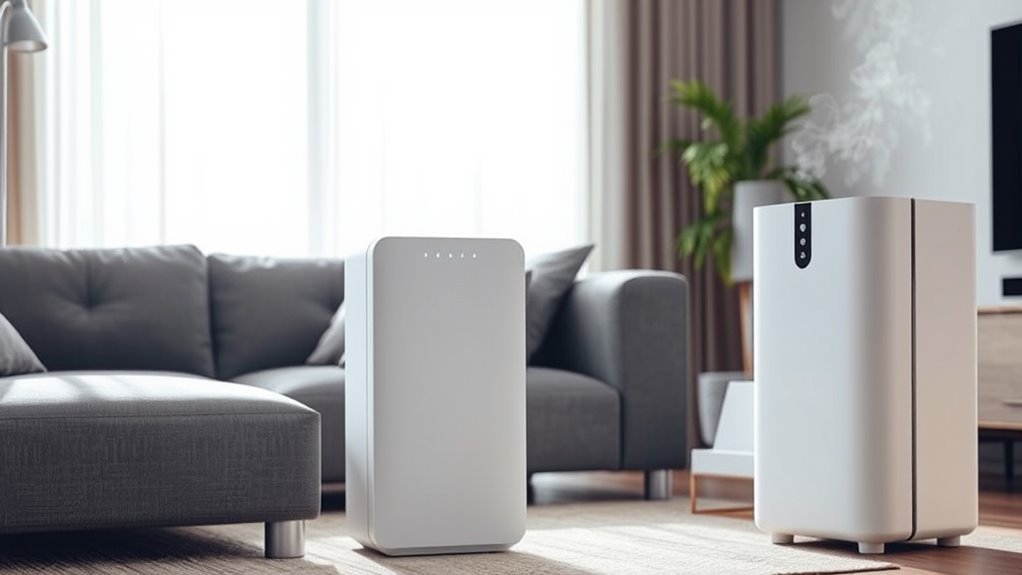
Using an air purifier can effectively remove pollutants and airborne particles from your home. This helps improve your respiratory health and makes breathing easier. Additionally, it reduces allergens in the air, creating a cleaner living environment for you and your family. Incorporating models with HEPA filters can further enhance the removal of microscopic particles, ensuring cleaner air in your space. Advances in machine learning algorithms are also helping develop smarter air purifiers that adapt to changing air quality levels for optimal performance. Moreover, many models now include UV light technology to kill germs and bacteria, further improving overall air safety. Research indicates that the proper filter maintenance significantly extends the lifespan and effectiveness of air purifiers.
Removes Air Pollutants
Have you ever wondered how air purifiers can improve the quality of your environment? They effectively remove common air pollutants like dust, pollen, pet dander, and smoke, helping you breathe cleaner air. By capturing particles that circulate in your indoor space, an air purifier reduces airborne contaminants that can worsen allergies or irritate your lungs. Regular device maintenance, like changing filters as recommended, guarantees it continues to perform at its best in removing pollutants. This keeps your air quality high and prevents buildup of dust and allergens inside the device. Using an air purifier creates a healthier environment, especially in areas with high pollution levels or allergens. Incorporating high-efficiency HEPA filtration ensures the removal of 99.97% of particles as small as 0.3 microns, further enhancing air purity. Understanding air filtration principles can optimize how effectively your device improves indoor air quality. Additionally, selecting a device with appropriate filter replacement indicators can help maintain optimal performance. Proper upkeep and choosing the right device can significantly impact indoor air quality, especially when considering air purifier types suitable for your specific needs. With proper upkeep, it consistently works to keep the air in your home fresh, clean, and free of harmful pollutants.
Improves Respiratory Health
Because airborne pollutants can irritate your lungs and worsen respiratory conditions, an air purifier can considerably improve your breathing. It captures airborne pathogens and reduces particles that cause respiratory infections, making it easier to breathe comfortably. Using an air purifier helps clear the air of pollutants that trigger asthma or bronchitis, providing relief and supporting respiratory health. To understand its benefits better, consider this table:
| Airborne Pathogens | Respiratory Infections | Breathing Ease |
|---|---|---|
| Bacteria | Cold, flu | Less coughing |
| Viruses | Sinus infections | Fewer irritations |
| Mold spores | Pneumonia | Improved airflow |
Regular use of an air purifier can also help allergen reduction, which is especially beneficial for allergy sufferers and homes with pets. Incorporating air filtration technology can enhance the overall air quality and further reduce airborne contaminants. Additionally, choosing a device with HEPA filters ensures the removal of tiny particles that traditional filters might miss. This advanced filtration system can significantly improve indoor air quality. Investing in an air purifier creates a healthier environment, especially if you suffer from respiratory issues.
Reduces Allergens in Air
Since airborne allergens like pollen, pet dander, and dust mites can trigger allergies and asthma, an air purifier actively helps by removing these particles from the air. HEPA filters are highly effective for allergen reduction, capturing at least 99.97% of particles as small as 0.3 microns. This means your air purifier can considerably lower the presence of common allergens, providing relief and creating a healthier environment. When you use an air purifier with HEPA filters, you reduce the allergens that circulate indoors, making it easier to breathe and minimizing allergy symptoms. Regular use ensures cleaner air, especially during allergy seasons or in homes with pets. Additionally, incorporating air quality tuning techniques can optimize the purifier’s performance for even better allergen removal. Overall, an air purifier is a practical investment for allergen reduction and improved indoor air quality.
Advantages of Using a Humidifier
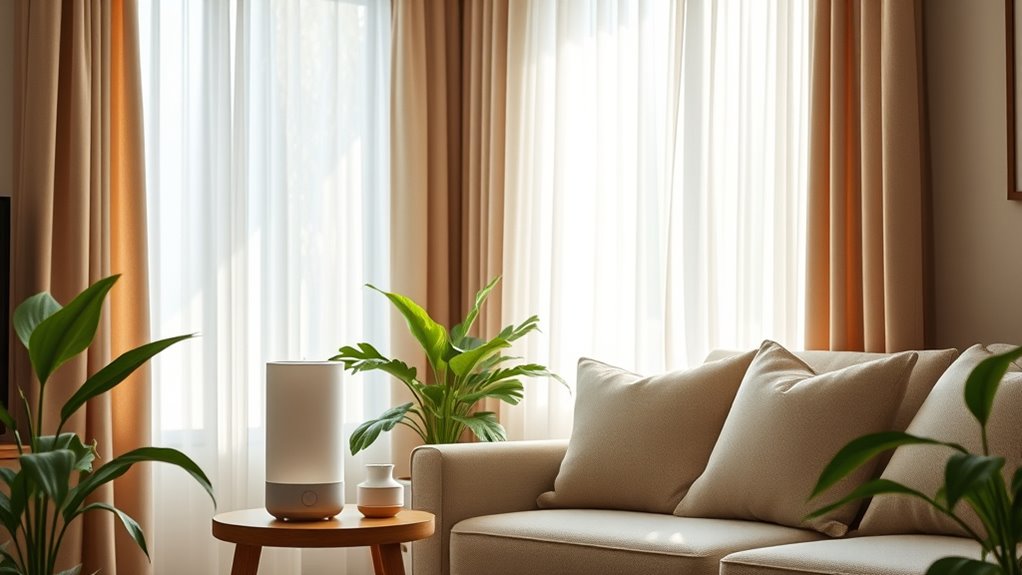
Using a humidifier helps relieve dryness naturally, making your skin and airways feel more comfortable. It also improves respiratory comfort by adding moisture to the air you breathe. Plus, it supports skin hydration, leaving you feeling more refreshed and less irritated. Additionally, using a humidifier can contribute to better overall air quality and reduce the likelihood of respiratory infections AI safety measures. Proper use of a humidifier can also help maintain a consistent indoor humidity level, which is essential for comfort and health. Maintaining optimal humidity levels can prevent issues like mold growth and dust mite proliferation, promoting a healthier indoor environment.
Relieves Dryness Naturally
Humidifiers naturally add moisture to the air, which can effectively relieve dryness in your skin, throat, and nasal passages. This is one of the key humidifier benefits, especially during dry seasons or in heated indoor environments. When your air lacks humidity, it can cause discomfort and irritation, but a humidifier provides simple dryness relief. Imagine feeling less scratchy or chapped, with your skin staying hydrated and your breathing easier. The following images help illustrate these benefits:
- Soft, hydrated skin feeling smooth and comfortable
- Reduced nasal congestion and irritation
- Easier breathing during cold or dry weather
- Less sore throat and coughing episodes
Using a humidifier is an easy way to naturally combat dryness and improve your overall comfort.
Improves Respiratory Comfort
By adding moisture to the air, humidifiers can markedly enhance your respiratory comfort. Dry air often worsens congestion and irritates your throat, making breathing uncomfortable. Humidifiers help soothe your airways, reducing coughing and congestion. They also diminish airborne viruses by maintaining ideal humidity levels, which can prevent viruses from thriving in your environment. Additionally, humidifiers aid in odor elimination by balancing humidity, making indoor spaces smell fresher and cleaner. When the air isn’t too dry, your lungs and nasal passages stay moist and better equipped to filter out irritants. This creates a healthier, more comfortable breathing environment, especially during winter months or in dry climates. Proper humidity levels support easier respiration and overall respiratory health.
Supports Skin Hydration
Maintaining proper skin hydration is another significant benefit of adding moisture to the air. When you use a humidifier, you help your skin retain its natural moisture, reducing dryness and irritation. Proper moisture retention keeps your skin soft, smooth, and healthy, especially during dry seasons or in heated indoor environments. By maintaining adequate humidity levels, you prevent skin from becoming flaky or cracked, which can lead to discomfort and aging signs. Additionally, hydrated skin improves the effectiveness of skincare products, allowing them to penetrate better.
- Feel your skin become plumper and more elastic
- Reduce itchiness and irritation caused by dryness
- Minimize fine lines and early aging signs
- Keep your skin looking fresh and glowing
When to Choose an Air Purifier
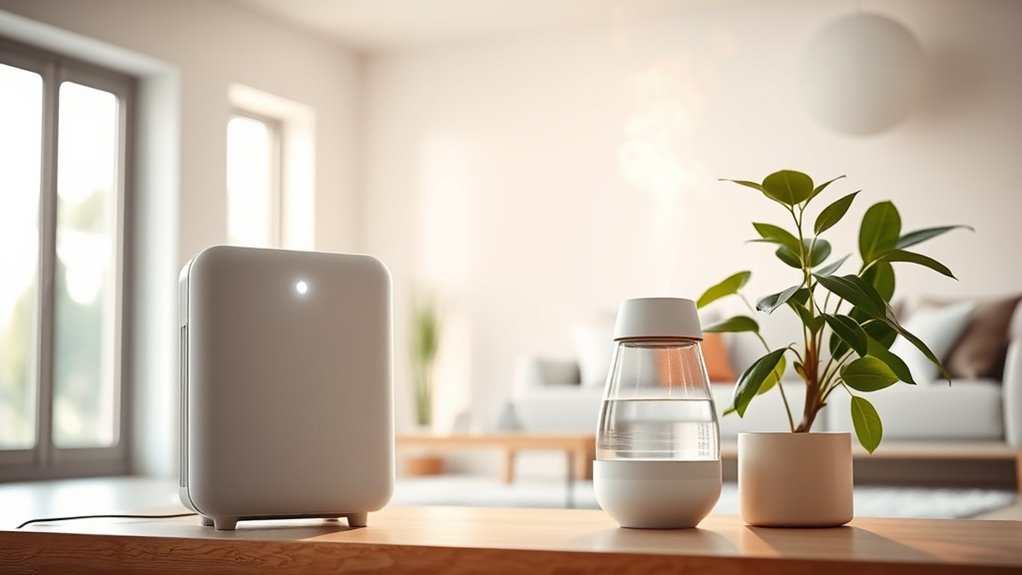
If you notice dust, pet dander, or airborne pollutants lingering in your home, an air purifier can make a noticeable difference. Choose one when improving your air quality is a priority, especially if you or your family members suffer from allergies or asthma. An air purifier effectively captures particles, reducing allergens and irritants in the air. Keep in mind, regular device maintenance is essential to guarantee maximum performance; filters need periodic replacement, and the device should be cleaned according to the manufacturer’s instructions. If you want cleaner, fresher air without affecting humidity levels, an air purifier is your best option. It’s especially useful in rooms with poor ventilation or where outdoor pollution seeps indoors.
When a Humidifier Is the Better Option
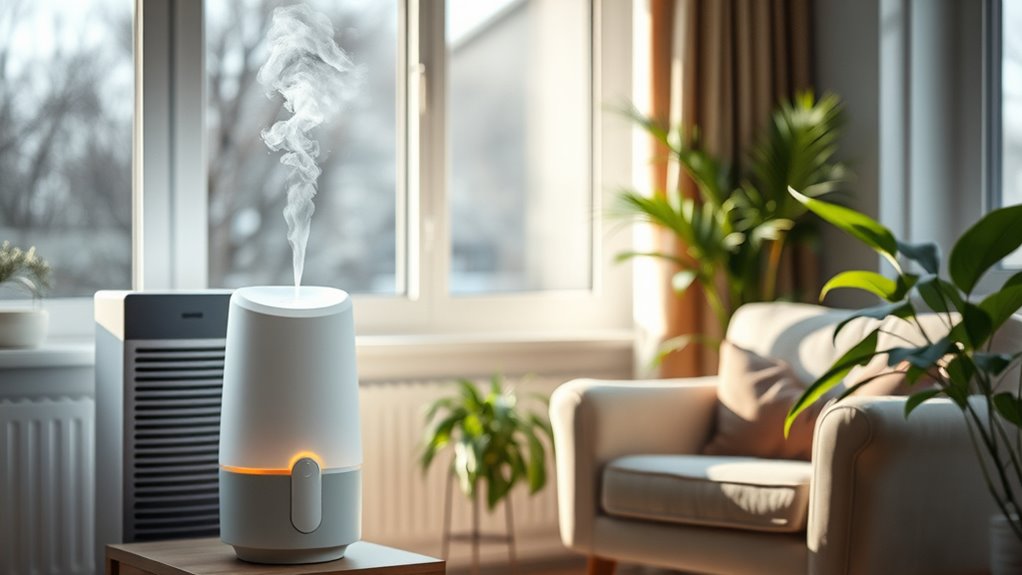
While air purifiers focus on filtering airborne pollutants, there are situations where adding moisture to the air can be more beneficial. When you need to improve humidity control, a humidifier is the better choice. It helps prevent dry skin, sore throats, and respiratory discomfort during winter or in dry climates. Additionally, maintaining proper humidity levels can inhibit mold growth by reducing excess moisture that mold thrives on. You might also consider a humidifier if you notice static electricity or cracked wood furniture. It’s especially useful when your indoor air feels dull or stuffy. By adding moisture, you create a healthier environment that minimizes mold prevention concerns and makes breathing easier. In these cases, a humidifier offers targeted relief that an air purifier cannot provide.
Potential Drawbacks of Each Device
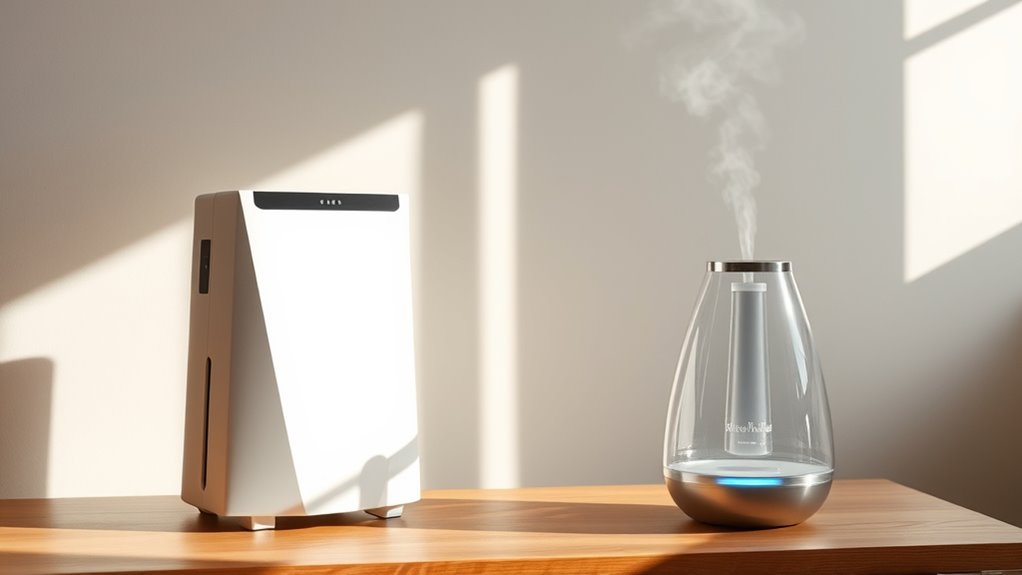
Both air purifiers and humidifiers come with their own set of drawbacks that you should consider before choosing one for your home. Air purifiers can be noisy, especially at higher settings, which might disturb your peace or sleep. They also tend to consume more energy, leading to higher utility bills over time. Humidifiers, on the other hand, may be quieter but require regular cleaning to prevent mold and bacteria buildup. Excess humidity from a humidifier can cause mold growth or dust mites, worsening allergies. Here’s a quick comparison:
| Drawback | Concern |
|---|---|
| Noise levels | Disrupts sleep or work |
| Energy consumption | Increases electricity bills |
| Maintenance | Regular cleaning needed |
| Humidity control issues | Mold or dust mite growth |
Combining Both Devices for Optimal Air Quality
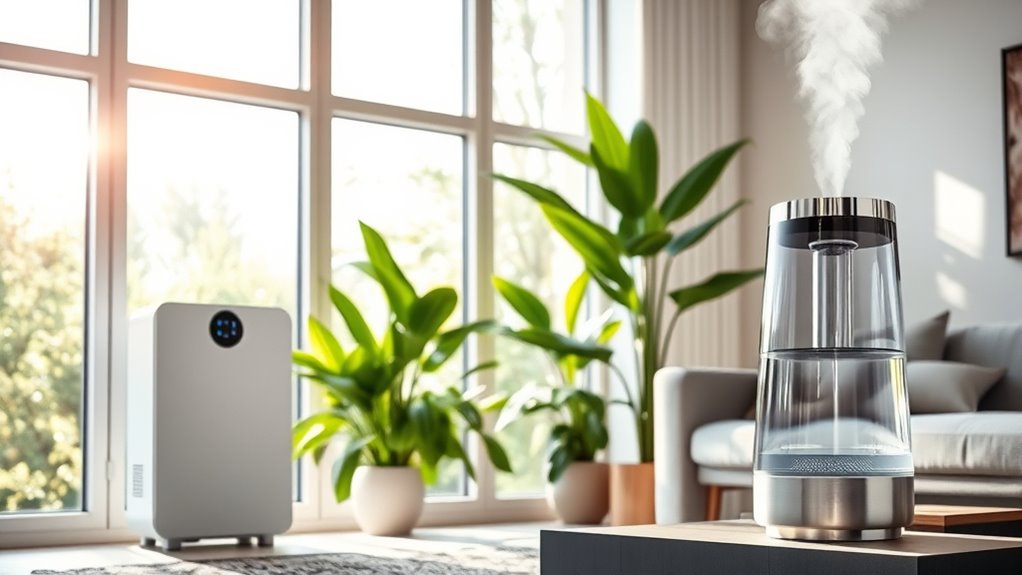
By combining air purifiers and humidifiers, you can achieve a healthier and more comfortable indoor environment. This synergy improves air quality by reducing pollutants and maintaining ideal humidity levels. To get the most out of both devices, consider these points:
- Regularly clean and replace filters to ensure device maintenance doesn’t hinder air purification.
- Place the purifier in high-traffic areas to maximize pollutant removal.
- Use the humidifier to balance humidity, preventing dry air that can irritate respiratory issues.
- Monitor humidity levels with a hygrometer to avoid over-humidification, which can promote mold growth.
Together, these devices work in harmony, creating cleaner, more breathable air that supports your well-being and minimizes indoor air quality concerns.
Making the Right Choice for Your Space
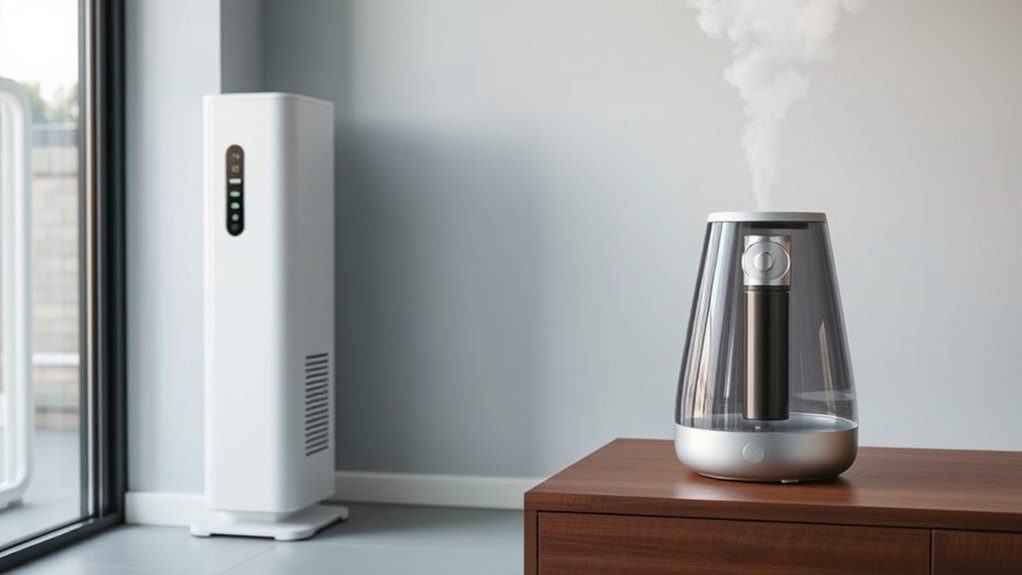
Choosing the right air purifier and humidifier for your space depends on your specific needs and the environment you’re aiming to improve. If air quality issues like dust, allergens, or pollutants are your main concern, an air purifier is essential. On the other hand, if dry air causes discomfort or respiratory issues, a humidifier will help. Consider the size of your room and how much maintenance each device requires; some filters need regular replacement, and humidifiers need cleaning to prevent mold. Think about your lifestyle and how often you’ll maintain the devices. Making an informed choice guarantees you address your air quality concerns effectively while keeping device maintenance manageable. This way, your space stays healthier and more comfortable.
Frequently Asked Questions
Can Air Purifiers and Humidifiers Be Used Simultaneously?
Yes, you can use air purifiers and humidifiers simultaneously, but you should verify device compatibility first. Some models work well together, while others may interfere with each other’s performance. Remember to follow maintenance scheduling for both devices to guarantee they function effectively and avoid issues like mold or dust buildup. Proper setup and regular upkeep help you enjoy cleaner, healthier air without any conflicts between the devices.
How Much Do Air Purifiers and Humidifiers Typically Cost?
Imagine your home as a castle, and your budget as the treasure chest. Air purifiers typically cost between $50 and $300, with budget options starting around $50. Humidifiers are usually more affordable, ranging from $20 to $100. Prices vary based on size and features, so shop around for the best price comparison. Whether you want a budget-friendly choice or a premium model, there’s an option for every throne room.
Are There Health Risks Associated With Using These Devices?
You should consider potential health risks from using these devices, like mold growth from humidifiers if not cleaned regularly or allergy flare-ups from air purifiers if filters aren’t maintained. Proper device maintenance is vital to prevent bacteria and dust buildup. To minimize risks, follow manufacturer instructions, replace filters as needed, and choose devices suited to your allergy considerations. Regular cleaning ensures safe, healthy use of both devices.
How Often Should I Replace Filters or Water in These Devices?
You should regularly check and follow the manufacturer’s guidelines for filter maintenance and water replacement. Typically, change air purifier filters every 3 to 6 months and replace humidifier water daily to prevent mold and bacteria. Staying consistent with filter maintenance and water replacement keeps your devices running efficiently, guarantees clean air and moist environments, and minimizes health risks. Always monitor your devices and replace components as needed for ideal performance.
Are There Specific Models Recommended for Allergy Sufferers?
If you’re looking for allergy-friendly models, you should consider recommended brands known for their effectiveness. Look for air purifiers with HEPA filters, as they trap common allergens like dust and pet dander. Brands like Dyson, Honeywell, and Blueair are highly recommended. These models help reduce allergy symptoms by improving air quality. Always check reviews and specifications to find the best fit for your needs, ensuring your environment stays comfortable and allergen-free.
Conclusion
Ultimately, choosing between an air purifier and a humidifier depends on what your space needs most. But imagine walking into a room where the air feels just right—neither too dry nor polluted. Will you prioritize clearing allergens or adding moisture? The decision isn’t always easy, and the right answer might surprise you. So, which device will you trust to transform your indoor air and create your perfect sanctuary? The choice is yours—are you ready to find out?
